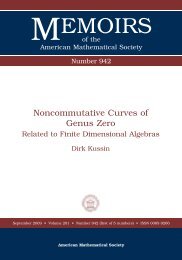University of Paderborn Department of Mathematics Diploma Thesis ...
University of Paderborn Department of Mathematics Diploma Thesis ...
University of Paderborn Department of Mathematics Diploma Thesis ...
You also want an ePaper? Increase the reach of your titles
YUMPU automatically turns print PDFs into web optimized ePapers that Google loves.
This thesis is organized in four chapters:Chapter 1.Notations and PrerequisitesIn order to enable not only readers with a good background in commutative algebraand algebraic geometry to follow the train <strong>of</strong> thought presented here, the first chapter<strong>of</strong> this thesis sets the stage: Basic terminology will be introduced to the readerand basic definitions will be recalled. Some well known results concerning primarydecomposition <strong>of</strong> ideals, saturation <strong>of</strong> ideals and Hilbert polynomials will be quoted.Another important result at the end <strong>of</strong> the first chapter is the characterization <strong>of</strong> theHilbert function <strong>of</strong> a homogeneous K-algebra, which goes back to F. S. Macaulayand will not be proved here, either. We will make use <strong>of</strong> this result, when we provethe correctness <strong>of</strong> an algorithm stated in Chapter 2. All results, which are statedand not proved at all, can be accepted without the knowledge <strong>of</strong> any details <strong>of</strong> theirpro<strong>of</strong>, since we will not make use <strong>of</strong> these details later.Chapter 2.Stable idealsIn the second chapter, we define Borel-fixed ideals. Under special conditions, wecharacterize these ideals by a certain property (due to [6]), which leads us to theclass <strong>of</strong> stable ideals. These ideals will be <strong>of</strong> main interest in the following chapters.The theory to compute the saturation, the Hilbert series or the Hilbert polynomial<strong>of</strong> a stable ideal is presented. To compute each <strong>of</strong> these, we give efficient algorithms.Furthermore we establish a link between Hilbert series and stable ideals, i.e. we willdescribe an algorithm to compute a unique saturated lexicographic ideal to a givenHilbert series <strong>of</strong> K[x 0 , . . . , x n ]/I for a saturated homogeneous ideal I ⊂ K[x 0 , . . . , x n ].We will see that this ideal is also stable. Similarly, we describe how to compute aunique saturated lexicographic ideal to a given Hilbert polynomial, which is again astable ideal. As an appendix <strong>of</strong> Chapter 2, we deal with an application <strong>of</strong> the formerresults to a consequence <strong>of</strong> Gotzmann’s Regularity Theorem (see [5], Chapter 3 ). Inparticular, we point out that Gotzmann’s upper bound on the degrees <strong>of</strong> the minimalgenerators <strong>of</strong> ideals to a given Hilbert polynomial cannot be improved.Chapter 3.Operations on stable idealsChapter three is the theoretical core <strong>of</strong> this thesis. For stable ideals, we define leftshiftsand right-shifts <strong>of</strong> monomials. We will explain, what has to be understoodunder expansions and contractions <strong>of</strong> monomials. The reader might think <strong>of</strong> theseconstructions as algorithmic tools, which will be used to compute all saturated stableideals to a given Hilbert polynomial. Later within this chapter, we will be able to4
















